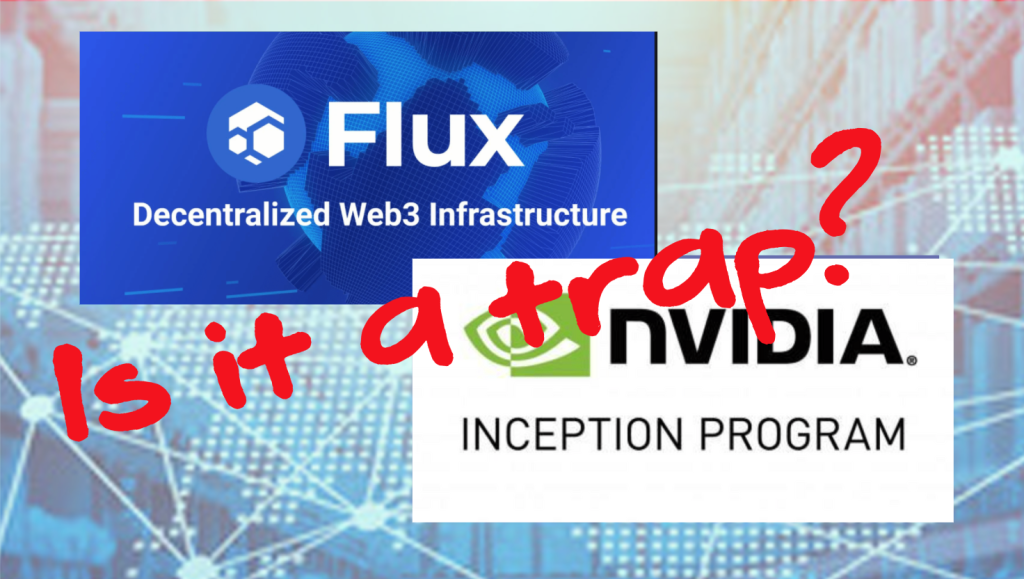It is worth asking, the author says, what does it mean that Nvidia has decided to work with Flux? Flux most likely relies on Nvidia’s technology, a company who has intentionally worked to exclude them from their customer base. Cynics might suspect Nvidia is trying to drain Flux of their knowledge while stealing their ideas (which big companies are prone to do). The more optimistic view is Nvidia might consider partnering with Flux in the future, recognizing that they wouldn’t have to run their own decentralized cloud network.

Flux recently announced they became a premier partner with NVIDIA through their inception program.
Being selected along with 90 other startups, Flux was the only cryptocurrency project of the bunch. The inception program by NVIDIA is free and designed to help startups get a flying start by getting acces to NVIDIA staff expertise, access to the latest technology, contacts with potential investors as well as co-marketing support for increasing the companys visibillity.
Now if you’re unfamiliar with Flux, it is a coin that has had a very good run last quater. Their objective is to create scalable decentralized cloud infrastructure for Web 3.0 If you look at their own pricing models, they seem to be very advantageous in comparison to the big cloud providers such as AWS or Azure. However, the main reason companies tend to go with big tech cloud providers doesn’t usually come down to price, more so that those cloud providers offer for instance various tools to analyze and store data.
Flux is a Proof-of-Work coin with its own operating system running on Linux. Node operators can choose three tires of hardware and Flux capital that has to be staked and with three levels of rewards being given accordingly. So despite being a very profitable coin to mine, for some GPUs even more profitable than Ethereum, they still share rewards 50/50.

This has partly to do with the node owners and miners being rewarded with not only Flux but also paralell assets currently. These parallel assets are intended to make the Flux governance coin to function on all DeFi protocols, including, Ethereum, Solana, Kadena, Binance Smart Chain, Tron, and in total 10 coins. These new parallel assets are airdropped to node stakers and miners alike.

What I consider perhaps most interesting regarding Flux is that they are developing something they call “Proof of Useful Work” to replace Proof of work for securing the Flux network. This will mean rather than solving randomized algorithms, Flux algorithms will solve real world problems. This would either entail supporting machine learning, AI, image rendering or scientific advancement simulations, such as the now already existing folding @ home software that allows computers all over the world to support protein simulations towards the same network.

Nvidia is, as all of those of you miners (or gamers) know, is the largest and market leading GPU manufacturer in the world, and have been so for quite some time.
Seeing them choosing Flux – A proof of work coin out of the only bunch for their inception program is quite weird, considering they have worked tooth and nail to shut down miners by introducing LHR cards. For those of you who aren’t miners, LHR – Lite Hash Rate means GPUs with a feature that ruins the hashrate for miners. They argued that this feature will make cards unattractive to miners to the extent that they will become more readily available for gamers.
So what does it mean that they now have changed their course and decided to work with Flux – a cryptocurrency that no doubt relies on the technology they have deliberately worked to exclude from their customer base?
Some speculate that it simply means that Nvidia chose basically those that fit the mold and didn’t care too much what companies participated. But would they deliberately provide support to a company that are no doubt going to continue to work against their efforts to block mining?
Others more cynically inclined might suspect that Nvidia are trying to drain Flux of their knowledge of how they run decentralized networks supported by GPU power, a technology that possibly could revolutionize the gaming industry. Or perhaps leverage what they learn about Flux mining support so they could block miners even more efficiently. While this whole thing sounds a bit far fetched, its not uncommon for these unfathomably large tech companies to swallow small startups whole and steal their ideas.
Those who are more optimistic regarding this deal say that Nvidia might even be interested in partnering with Flux in the future, realizing that they don’t need to run their own decentralized cloud network if they could have Flux run it for them and perhaps find a way to work in symbiosis, each company gaining from the others strengths.
Regardless, the Flux team seems to consider this an exciting partnership, and perhaps it is just that: Two companies – one major and one startup – learning from each other.
Although the material contained in this website was prepared based on information from public and private sources that FLUXhighway.com believes to be reliable, no representation, warranty or undertaking, stated or implied, is given as to the accuracy of the information contained herein, and FLUXhighway.com expressly disclaims any liability for the accuracy and completeness of the information contained in this website.
Via this https://www.publish0x.com/crypto-bulletin/is-nvidia-luring-flux-into-a-trap-xppkowq

